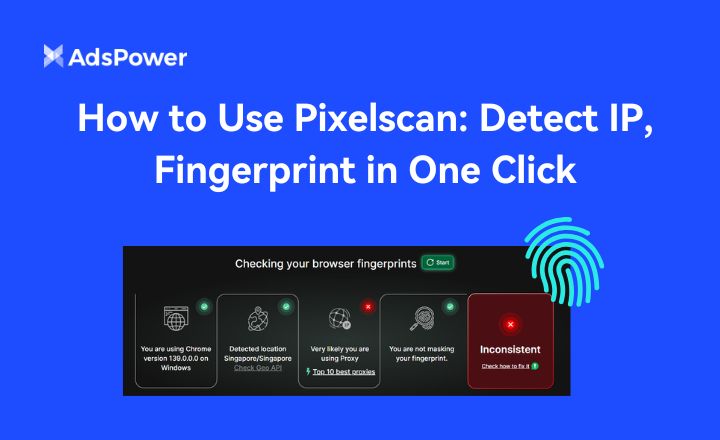What is Browser Fingerprinting?
In today's digitally interconnected world, where anonymity seems elusive, a digital trail reveals more about us than we might suspect. Welcome to the enigmatic realm of browser fingerprinting – a sophisticated and discreet technique uniquely portraying every internet user. But what exactly is a browser fingerprint?
A browser fingerprint is an intricate amalgamation of various attributes and configurations that distinguish one user's web browser from another. This digital signature includes data points like the user agent string, HTTP headers, installed plugins, and screen resolution, forming a distinct identity for each online visitor.
Like our physical fingerprints, browser fingerprints unveil a wealth of information, providing a window into our virtual lives.
This article delves into the intricate world of browser fingerprinting, unraveling its functioning, applications, pros, and cons. Moreover, it explores the ethical and legal dimensions, offering practical tips to mitigate its impact and empowering readers to strike a delicate balance between personalization and preserving digital sovereignty.

Understanding Browser Fingerprinting
Browser fingerprinting is a powerful technique employed by websites and online trackers to identify and differentiate individual users based on a wide array of unique attributes and configurations present in their web browsers. Piecing together various data points creates a digital signature for each user, allowing websites to track them across different browsing sessions and devices.
Browser fingerprinting works by gathering a multitude of pieces of information from a user's web browser, which is then amalgamated to create a distinctive profile.
Components of a Browser Fingerprint
Below are the elements that contribute to this fingerprinting process:
1. User Agent String: This is a snippet of text sent to the server by the browser when accessing it. It contains details about the browser type, version, operating system, and device type, offering valuable insights into the user's device and software.
2. HTTP Headers: HTTP headers are additional information the browser transmits with each request. These headers include details about the browser's accepted content types, supported encodings, and other specific preferences, which help fine-tune the fingerprint.
3. Plugins and Extensions: The presence and version details of plugins and extensions installed in the browser provide crucial clues about the user's software environment. Different users may have a unique combination of plugins, further distinguishing them by their fingerprints.
4. Time Zone and Language Settings: The time zone and language settings reflect the user's geographical location and language preferences, adding another layer of distinctiveness to the fingerprint.
5. Screen Resolution and Color Depth: These values reveal the user's display characteristics, which can be relatively specific, contributing to the uniqueness of the fingerprint.
6. Cookies and Local Storage: Cookies and local storage store information on the user's device. The presence of specific cookies or the data stored locally can provide insights into the user's previous interactions with a website.
7. Canvas and WebGL Fingerprinting: Canvas fingerprinting involves drawing and rendering graphics in the user's browser. WebGL fingerprinting exploits the device's graphics rendering capabilities. These techniques analyze how the browser handles these tasks, leading to subtle variations in the fingerprint.
8. Audio and Video API Fingerprinting: By probing the browser's handling of audio and video APIs, websites can create unique fingerprints based on slight differences in API support and performance across devices.
Fingerprinting Techniques and Methods
1. Active Fingerprinting: Active fingerprinting involves using JavaScript and other client-side scripts to collect detailed information about the user's browser and device. Websites can execute scripts and analyze responses to build a comprehensive fingerprint.
2. Passive Fingerprinting: Passive fingerprinting relies on the browser's default behavior and characteristics without executing additional scripts. It leverages information in standard HTTP requests and responses to create a fingerprint, making it more difficult for users to detect and control.
Differences Between Browser Fingerprinting and IP Address Tracking
While both browser fingerprinting and IP address tracking are used for user identification and tracking, they differ in their approach and level of granularity:
Browser Fingerprinting
- It relies on a combination of browser attributes and configurations.
- It offers a higher level of granularity, allowing for more precise identification of individual users.
- It works across different networks and devices, effectively tracking users even if their IP addresses change.
IP Address Tracking
- It relies on the unique numerical address assigned to each device connected to a network.
- It provides a broader identification method, as multiple users within the network may share the same IP address (e.g., public Wi-Fi networks).
- IP addresses may change with network connections, making them less reliable for long-term user tracking.
Applications of Browser Fingerprinting
With its ability to uniquely identify users based on browser attributes and configurations, browser fingerprinting finds application in various aspects of the digital landscape. From targeted marketing to fraud detection, let's explore some key applications of this sophisticated technique.

Online Tracking and Profiling
- Behavioral Advertising and Targeted Marketing: Browser fingerprinting enables advertisers and marketers to create detailed profiles of users' online behaviors and interests. By tracking browsing habits, websites visited, and interactions with online content, advertisers can deliver personalized advertisements that align with users' preferences, increasing the likelihood of engagement and conversions.
- Tracking User Preferences and Behavior: Website owners can gain valuable insights into users' preferences and behavior through browser fingerprinting. This data helps them optimize user experiences, tailor content, and improve site usability, ultimately enhancing customer satisfaction and retention.
Fraud Detection and Prevention
- Identifying Bot Activities and Automated Requests: Browser fingerprinting is crucial in fraud detection because it distinguishes human users from automated bots. Bots often generate predictable and consistent fingerprints, making it easier for security systems to identify and block suspicious activities such as automatic form submissions or spam attacks.
- Analyzing Suspicious User Behavior: Browser fingerprinting aids in detecting abnormal user behavior that might indicate fraudulent activities or security breaches. Unusual patterns or discrepancies in fingerprints can trigger alerts for further investigation, allowing businesses to respond to potential threats proactively.
User Authentication and Device Recognition
- Recognizing Trusted Devices and Users: Websites can use browser fingerprinting to identify trusted devices and users for authentication. Users can access their accounts securely without repeatedly entering login credentials by associating specific fingerprints with authorized accounts.
- Authentication and Anti-Fraud Measures: In tandem with traditional authentication methods, browser fingerprinting provides an additional layer of security against identity theft and account takeover attempts. Comparing a user's current fingerprint with their known fingerprint history helps detect suspicious login attempts and triggers additional security measures like multi-factor authentication.
While browser fingerprinting offers valuable applications across various domains, it also raises concerns regarding online privacy and the potential misuse of user data. Website owners and businesses must adopt ethical practices, transparently inform users about fingerprinting techniques, and provide them with options to manage their privacy preferences.
Pros and Cons of Browser Fingerprinting
Browser fingerprinting has emerged as a powerful tool for tracking and identifying users on the Internet. While it offers several advantages, it has significant drawbacks that raise concerns about user privacy and data security.
Advantages
- No Reliance on Cookies: Unlike traditional tracking methods that rely on cookies, browser fingerprinting does not require storing data on the user's device. This makes it more resilient to cookie-blocking technologies and ensures persistent tracking even when users clear their cookies.
- Effective Tracking Across Multiple Devices: Browser fingerprinting creates unique identifiers based on a combination of attributes, allowing for effective cross-device tracking. This means that websites can still recognize and associate their fingerprints, providing a seamless user experience across different platforms even if a user switches devices.
- Enhancing the User Experience with Personalization: By capturing detailed information about user behavior and preferences, browser fingerprinting enables personalized content delivery. Websites can tailor their offerings based on the user's interests, improving user satisfaction and engagement.
Disadvantages
- Privacy Concerns and User Anonymity: One of the major concerns with browser fingerprinting is the potential invasion of user privacy. As fingerprinting techniques track users across websites, it raises questions about consent and anonymity, as users may not be aware that their digital activities are being monitored.
- Potential for Misuse and User Profiling: The vast amount of data collected through browser fingerprinting can be misused or exploited for user profiling. Advertisers and malicious actors could build comprehensive profiles of users, leading to targeted advertising or even discrimination based on sensitive information.
- Inaccuracy and Unreliable Data: Browser fingerprinting is not foolproof and may generate false positives or inaccuracies, leading to misidentification of users. Factors such as browser settings, device configurations, and network conditions can influence the fingerprint, potentially leading to incorrect assumptions about a user's identity.
- Browser Updates and Changes Impacting Fingerprints: As browsers update and evolve, certain attributes used for fingerprinting may change or become deprecated, affecting the accuracy and persistence of fingerprints. This dynamic nature of browser fingerprinting can make maintaining reliable tracking methods challenging.
Browser Fingerprinting and Online Privacy
As browser fingerprinting plays a significant role in tracking and identifying users, concerns regarding online privacy have become more pronounced. Safeguarding user data and ensuring ethical practices are crucial for maintaining trust in the digital ecosystem.
Here are the legal and ethical considerations surrounding browser fingerprinting and effective strategies to mitigate its impact on online privacy.
Legal and Ethical Considerations
1. Privacy Regulations and Compliance: With the rise of privacy regulations like Europe's General Data Protection Regulation (GDPR) and USA's California Consumer Privacy Act (CCPA), websites and companies must be transparent about data collection. They must obtain user consent and provide clear information about browser fingerprinting techniques.
2. Ethical Use of Browser Fingerprinting Data: Responsible data practices entail using browser fingerprinting data for legitimate and moral purposes. Websites should avoid misusing this data for invasive profiling, discrimination, or other unauthorized activities infringing on user privacy.
Mitigating Browser Fingerprinting
1. Browser Privacy Extensions and Tools: Several browser privacy extensions and add-ons help users protect their online privacy. These tools can block or modify the data collected by fingerprinting scripts, making it more challenging for websites to build accurate and persistent user profiles.
2. Using Encrypted Network Services and Proxy Servers: Encrypted network services and proxy servers can mask the user's IP address, making it harder for websites to associate their online activity with a particular individual or device. These tools route the user's internet traffic through secure servers, providing an added layer of privacy.
3. Using Antidetect Browsers: Antidetect browsers like AdsPower are built with capabilities to migitage most forms of browser fingerprinting. With AdsPower, you can operate multiple browser profiles with native fingerprints. Each of these fingerprints is unique and remains the same every time you work with the profile. In this way, websites will believe that a real visitor is behind each profile and won't block your accounts.
4. Limiting Browser Information and Disabling Features: Users can take steps to limit the information available to fingerprinting scripts by turning off certain browser features. For example, adjusting browser settings to block certain APIs or disabling JavaScript can hinder the collection of detailed attributes.
Conclusion
Browser fingerprinting presents a double-edged sword in the realm of online privacy. While it enables personalized experiences and fraud prevention, it raises significant concerns about user anonymity and data misuse. Adherence to privacy regulations, ethical data practices, and user consent are imperative for responsible implementation.
Additionally, users can proactively protect their privacy by employing browser privacy tools and encrypted network services, and limiting browser information. Striking a delicate balance between technological advancements and user privacy is crucial to fostering a secure and respectful digital environment.

People Also Read
- 8 Best Whoer Alternatives in 2026 ( Accurate & Private IP Check Tools)

8 Best Whoer Alternatives in 2026 ( Accurate & Private IP Check Tools)
Looking for a Whoer.net alternative? Discover our 2026 list of the 8 best IP check tools for accurate, private fingerprint analysis and enhanced onlin
- What Is WebRTC Used For? Does WebRTC Leak Your IP Address?

What Is WebRTC Used For? Does WebRTC Leak Your IP Address?
Learn what WebRTC is, what it's used for, whether it leaks your IP address, and how to stay protected with tools like AdsPower's WebRTC modes.
- What is BrowserScan? Check Fingerprints, IP Leaks & Stay Private

What is BrowserScan? Check Fingerprints, IP Leaks & Stay Private
What is BrowserScan? Find out how it detects IP leaks & unique fingerprints, plus tips for privacy with AdsPower.
- How Does AmIUnique Work and Is It Safe? Everything You Need to Know

How Does AmIUnique Work and Is It Safe? Everything You Need to Know
Discover how AmIUnique reveals your browser fingerprint, whether it's safe, the best alternatives, and expert tips to protect your online privacy.
- Pixelscan Review 2025: Features, Uses & Best Alternatives

Pixelscan Review 2025: Features, Uses & Best Alternatives
Pixelscan lets you check your IP and fingerprint; discover the best alternatives of Pixelscan to enhance security and privacy online.


